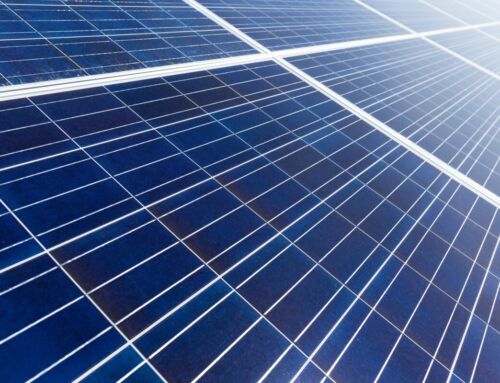Understanding the Basics of Energy Transformation in a Solar Panel
Energy Transformation in a Solar Panel through a fascinating process that blends science with sustainability. At the core of this transformation are photovoltaic (PV) cells, primarily made from silicon, a semiconductor material. When sunlight strikes these cells, it excites electrons, causing them to move and generate electricity. This process is akin to a dance where sunlight leads and electrons follow, creating a continuous flow of energy.
Key Benefits of Energy Transformation in a Solar Panel:
- Renewable and Sustainable: Solar energy is abundant and inexhaustible, offering a sustainable alternative to fossil fuels.
- Reduces Carbon Footprint: By converting sunlight into electricity, solar panels help lower greenhouse gas emissions.
- Cost-Effective in the Long Run: Despite high initial costs, solar panels can significantly reduce electricity bills over time.
Real-world applications of solar energy are widespread, from residential rooftops to expansive solar farms. A notable example is the Solar Star project in California, one of the largest solar farms globally, which powers over 250,000 homes. Understanding these basics highlights how solar panels are not only technological marvels but also essential tools in our pursuit of a cleaner, greener planet.
How Solar Panels Convert Sunlight into Usable Energy
Energy Transformation in a Solar Panel through a fascinating process that combines science and technology. At the core of this transformation are photovoltaic (PV) cells, primarily made from silicon, which absorb photons from sunlight. This absorption process knocks electrons loose, creating an electric current through the photovoltaic effect, where light is directly converted into electricity.
Here’s a simplified breakdown of the process:
- Photon Absorption: Sunlight, composed of photons, strikes the solar panel.
- Electron Excitation: Photons energize electrons in the silicon cells, causing them to move.
- Current Generation: The movement of these electrons generates a direct current (DC).
- Inversion to AC: An inverter then converts this DC into alternating current (AC), suitable for home use.
This transformation is not only a scientific marvel but also a practical solution to energy needs. In sunny regions like California, solar panels can significantly reduce electricity bills and carbon footprints. With technological advancements, solar panels are becoming more efficient and affordable, making them a viable option for many households. Understanding this process highlights the role solar panels play in promoting sustainable living.
The Role of Photovoltaic Cells in Energy Transformation
Solar panels, those sleek surfaces soaking up the sun, owe their functionality to photovoltaic cells. These cells are the core components that convert sunlight into electricity, playing a crucial role in energy transformation. Made from semiconductor materials like silicon, photovoltaic cells undergo a fascinating process when exposed to sunlight. Here’s how it works:
- Absorption of Sunlight: Photons from sunlight are absorbed by the cells.
- Electron Excitation: This energy excites electrons, freeing them from their atoms.
- Electric Field Creation: An internal electric field directs these electrons, generating an electric current.
This seemingly complex process is how solar panels turn sunlight into usable electricity. The efficiency of this transformation hinges on factors like the quality of the cells and sunlight exposure. In practical terms, this energy conversion powers everything from small devices to entire homes. For example, in sunny places like California, solar panels are prevalent on rooftops, cutting electricity costs and promoting environmental sustainability. As technology progresses, photovoltaic cells become more efficient and affordable, enhancing solar energy’s role as a sustainable power source.

Thinking about solar energy? See how it can lower your bills and elevate your home’s efficiency. Get Your Free Estimate at NewSolar Quotes
Key Components of Solar Panels and Their Functions
Solar panels are ingenious devices that convert sunlight into electricity through energy transformation. This process relies on several essential components, each crucial for efficient solar energy harnessing.
Photovoltaic Cells are the heart of solar panels, made from silicon semiconductors. They convert sunlight into electricity by exciting electrons to create an electric current, marking the core of energy transformation.
Inverters play a vital role by converting the direct current (DC) generated by photovoltaic cells into alternating current (AC), which powers homes and businesses. Without this conversion, the electricity would be unusable for most appliances.
The Mounting System secures solar panels to rooftops or ground installations, ensuring optimal positioning to capture maximum sunlight, thus enhancing energy transformation efficiency.
A Monitoring System tracks the solar panel system’s performance, offering real-time data on energy production and usage. This helps identify issues early, ensuring peak operational efficiency. These components collectively lead to significant benefits:
- Increased Energy Efficiency: Maximizes energy conversion.
- Cost Savings: Reduces reliance on traditional energy, lowering bills.
- Environmental Impact: Decreases carbon footprints, promoting a cleaner environment.
Understanding these components highlights how solar panels transform sunlight into a sustainable energy source, powering homes and businesses with renewable energy.
The Science Behind Solar Energy Conversion Efficiency
Solar panels, with their sleek, shiny surfaces, are more than just a pretty face; they are a marvel of energy transformation. At the core of this process is the photovoltaic effect, where sunlight is converted into electricity. This transformation begins with photovoltaic cells, primarily made from silicon, which absorb sunlight’s photons. These photons dislodge electrons, creating an electrical flow that is then harnessed for power. Real-world applications of this technology are vast, from residential rooftops to massive solar farms like California’s Solar Star, which powers hundreds of thousands of homes. This highlights solar energy’s potential to sustainably meet our energy demands. To enhance solar energy conversion efficiency, several advancements are underway:
- Material advancements: New materials like perovskite are being researched to surpass the efficiency of traditional silicon cells.
- Innovative designs: Bifacial panels capture sunlight on both sides, boosting energy output.
- Smart technology integration: AI and IoT optimize panel positioning and performance.
Understanding this science not only showcases solar power’s potential but also emphasizes the need for ongoing innovation, paving the way for a sustainable energy future.

Exploring the Process of Photovoltaic Energy Transformation
Photovoltaic energy transformation is the process by which sunlight is converted into electricity using solar panels. These panels, primarily composed of silicon photovoltaic cells, capture sunlight and transform it into usable energy. When sunlight strikes these cells, photons dislodge electrons from their atoms, creating an electric field that generates a flow of electricity.
This direct current (DC) is then converted into alternating current (AC) by an inverter, making it suitable for household use. The advantages of photovoltaic energy transformation are significant. Solar energy is a renewable resource that reduces dependence on fossil fuels and decreases greenhouse gas emissions. Additionally, solar panels can lower electricity costs and offer energy independence. Real-world applications range from residential rooftops to expansive solar farms.
For example, solar panels on homes in California not only supply power but also feed excess energy back into the grid, highlighting the transformative potential of solar technology. Overall, photovoltaic energy transformation is a vital component of sustainable energy strategies, providing a cleaner, greener alternative to conventional power sources. As technology progresses, solar panels become more efficient and accessible, making them an increasingly practical choice for both homes and businesses.
Innovations in Solar Panel Technology and Energy Transformation
Energy Transformation in a Solar Panel, inefficient devices into sleek, high-performance energy systems. Central to this evolution is the photovoltaic (PV) cell, which converts sunlight into electricity. This process, known as the photovoltaic effect, begins when sunlight strikes the PV cells, typically made of silicon. The cells absorb photons, freeing electrons from their atoms and generating an electric current. This current is then used to power various applications, from homes to vehicles. Recent technological advancements have greatly enhanced solar panel efficiency and versatility. Notable innovations include:
- Bifacial Solar Panels: These panels capture sunlight from both sides, boosting energy output by up to 20% compared to traditional models.
- Perovskite Solar Cells: These offer a cost-effective and flexible alternative to silicon, promising higher efficiency and simpler manufacturing processes.
- Floating Solar Farms: Installed on water bodies, these farms save land space and benefit from cooler temperatures, which enhance efficiency.
These advancements not only improve Energy Transformation in a Solar Panel but also make solar power more accessible and sustainable. As technology progresses, solar energy’s potential to reshape our energy landscape continues to grow.
Environmental Benefits of Solar Energy Transformation
Solar panels represent a significant leap towards sustainability by converting sunlight into electricity through photovoltaic cells. This transformation is not only efficient but also environmentally friendly, offering numerous benefits that contribute to a healthier planet. One of the key advantages is the reduction of greenhouse gas emissions. Unlike fossil fuels, solar panels generate electricity without releasing carbon dioxide or other pollutants, leading to cleaner air and a smaller carbon footprint. The environmental benefits of solar energy transformation include:
- Reduction in Air Pollution: Solar panels decrease reliance on coal and natural gas, major sources of air pollution.
- Conservation of Water Resources: Solar systems require minimal water for maintenance, unlike traditional power plants.
- Mitigation of Climate Change: By cutting greenhouse gas emissions, solar energy helps combat climate change.
Cities like San Diego exemplify the real-world impact of solar energy, powering public buildings with solar technology and significantly reducing emissions. As more communities and businesses adopt solar solutions, the collective environmental impact grows. Ultimately, solar energy transformation not only provides a renewable power source but also paves the way for a cleaner, greener future, encouraging everyone to contribute to a healthier planet.
Challenges in Maximizing Energy Transformation in Solar Panels
Solar panels are pivotal in renewable energy, yet maximizing their energy transformation presents challenges. A significant hurdle is the efficiency of converting sunlight into electricity. Despite advancements, panels face limitations due to material constraints and environmental conditions.
Material Limitations: The efficiency of solar panels is primarily influenced by the materials used. Silicon, the prevalent choice, has a theoretical efficiency cap at about 33%, known as the Shockley-Queisser limit. Although alternative materials like perovskite offer potential for higher efficiency, they remain largely experimental.
Environmental Factors: Real-world conditions such as dust, shading, and temperature fluctuations can adversely affect solar panel performance. Dust accumulation and shading from trees or buildings reduce sunlight exposure, while extreme temperatures decrease efficiency. Regular maintenance and strategic placement can alleviate some of these issues.
- Dust and Debris: Regular cleaning is essential for optimal performance.
- Shading: Proper placement minimizes shading effects.
- Temperature: Developing cooling technologies can enhance efficiency in high temperatures.
Despite these challenges, technological advancements and innovative solutions are continually improving solar panel efficiency, paving the way for more sustainable energy production and a greener future.
Future Trends in Solar Energy Transformation Technology
Energy Transformation in a Solar Panel, driven by innovative technologies that enhance how we capture and use sunlight. Central to this evolution is the photovoltaic (PV) cell, which converts sunlight into electricity. Let’s delve into the promising trends shaping the future of solar energy transformation.
Enhanced Efficiency:
- Perovskite Solar Cells are revolutionizing the field with higher efficiency rates and lower manufacturing costs compared to traditional silicon cells, paving the way for broader adoption.
- Bifacial Panels capture sunlight from both sides, boosting energy output, especially in reflective environments like snowy or watery areas.
Integration with Smart Technology:
- The use of IoT and AI in solar systems allows for real-time monitoring and optimization, maximizing energy production.
- Smart Grids improve energy distribution and storage, reducing waste and enhancing solar power reliability.
Sustainability and Recycling:
- Eco-friendly Materials are being developed to make solar panels easier to recycle, lessening their environmental impact.
- Circular Economy Models focus on reusing and recycling solar components, promoting sustainability.
These advancements in efficiency, smart technology, and sustainability ensure that solar panels will play a crucial role in the global shift towards renewable energy, offering smarter choices for both homeowners and businesses.
FAQ
-
How does a solar panel transform energy?
It converts sunlight (solar energy) into electricity using photovoltaic (PV) cells. -
What type of energy does a solar panel produce?
It generates direct current (DC) electricity, which is later converted to alternating current (AC) for home use. -
What is the efficiency of energy conversion in solar panels?
Modern panels have 15-22% efficiency, meaning they convert that percentage of sunlight into usable power. -
Do solar panels work without direct sunlight?
Yes, they work on cloudy days, but energy production is reduced. -
What factors affect solar panel energy transformation?
Panel quality, angle, shading, and temperature impact efficiency.
Switch to solar and start saving now! Don’t miss out on a cleaner, cost-effective energy solution. Schedule Your Free Consultation at NewSolar Quotes
Discover more ways to save with solar! Visit New Solar Quote and see the potential for your home.





